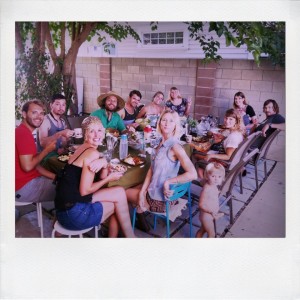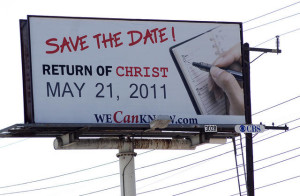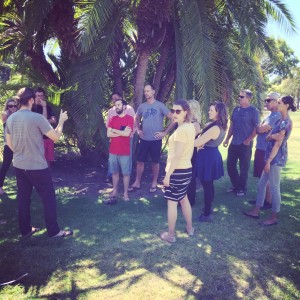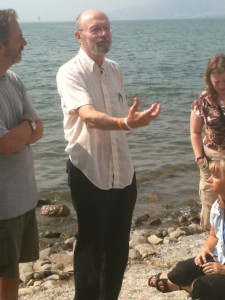 The longer we live in our neighborhood and enter into deeper relationships with a handful of the 13,000 people who live within the 10 X 7 blocks of Golden Hill, the more we become aware of the importance of the faithfulness of our little faith community in this place. We are discovering that the majority of our neighbors would never consider attending a traditional church (for a variety of reasons) and many others who have attended churches in the past have been deeply hurt, disillusioned or disconnected from the church communities of their past.
The longer we live in our neighborhood and enter into deeper relationships with a handful of the 13,000 people who live within the 10 X 7 blocks of Golden Hill, the more we become aware of the importance of the faithfulness of our little faith community in this place. We are discovering that the majority of our neighbors would never consider attending a traditional church (for a variety of reasons) and many others who have attended churches in the past have been deeply hurt, disillusioned or disconnected from the church communities of their past.
So is that it? Game over?
No, far from it. As we find ourselves invited (and inviting) deeper into the lives of our neighbors we are discovering it is just the beginning. Whether walking with women through pregnancy and supporting them in the intimacy of child birth or officiating weddings of those who wouldn’t otherwise have a “pastor” in their life or sitting on our patio with the war veteran enduring PTSD or checking in on the elderly man next door or sharing a meal with a friend in the park who doesn’t have a home or simply offering a warm greeting to those on our sidewalks, we are embracing the fact that our neighborhood is our parish and we are its pastors.
So, if we believe Jesus is the hope of the world and that the Church plays a role in God’s mission of reconciliation, then how might the Church express itself in a neighborhood like ours?
There must be a movement of us that rise up not to impose our beliefs on our neighbors, but to simply walk with them, care for them, encourage them in the realities of everyday life and empower them to live more fully into who they were created to be.
Doubts.
Loss.
Career transition.
Children.
Marriage.
Play.
Those who embrace this pastorate can’t reduce our congregants to those who come in our buildings once or twice a week. No, our congregants are the people we share life with everyday. There is a building movement of those who are retracing our pastoral roles back to the ancient idea of parish. The neighborhood (the physical place where we live, work and play) is the new parish and we are its pastors.
We have meals in our homes. We take care of each other’s children. We offer marriage support and counseling when they’re in need. When our neighbors are the most vulnerable, we hold space for them to experience the gift of simply being present. In those spaces, both the presence of Jesus and the presence of the Jesus Community is made real.
Further, in this pastorate of everyday relationship, we open ourselves up to be pastored by our neighbors. Genuine relationship doesn’t run one direction, it is an act of mutual submission that frees us to fully share and receive love…even if from the most unexpected people and places.
This isn’t a walking away from formal leadership in the Church, it’s our faithful act to fully embrace the pastoral vocation we have been called to live out each and everyday.
It’s hard. It’s ambiguous. The metrics are difficult to calculate at times. The pain often outweighs the hope. We don’t get a platform or a microphone. Instead, we are given the gift of genuine relationship. Relationship where we are as formed as those we form.
In this pastorate, there will be no title that assumes leadership or authority. No, our only authority comes when we have fully submitted ourselves to our neighborhoods and lead with tangible acts of humble presence and long-term commitment.
I’m not saying the role of pastor in a “traditional” sense is bad or wrong or unnecessary. It is surely needed! What I am saying is that it’s time we expand our definition of pastor and begin to create tangible pathways for those of us called to this form of pastoring to be mobilized, equipped and sent to participate with God in the people and places far off the beaten path of most churches influence.
———-
NOTE:
1. Our Thresholds Missional Community Cohort – of which I’m on the leadership team – is committed to the coaching, training and mobilizing of this very kind of pastor. A pastor who is leading embedded communities of faith and reconciliation.
2. My dear friends of the Parish Collective recently wrote a book that fills out the theological, historical and practical implications of taking seriously this form of pastorate. It is called The New Parish: How Neighborhood Churches are Transforming Mission, Discipleship and Community.
 Through my work with
Through my work with  This Sunday, the Church concludes the 50 day Easter season with Pentecost. Pentecost celebrates the giving of the Holy Spirit and reminds us that our story isn’t static, but dynamic, alive and unfolding. It reminds us that we are a people marked by both what has happened AND what is happening. It reminds us that our primary work isn’t to defend and isolate ourselves from the world around us, but to move into it as ambassadors of hope and reconciliation. In the same way that the disciples moved out from Jerusalem after Pentecost, we are to move out of our places of comfort and complacency as we join God in the world he is making.
This Sunday, the Church concludes the 50 day Easter season with Pentecost. Pentecost celebrates the giving of the Holy Spirit and reminds us that our story isn’t static, but dynamic, alive and unfolding. It reminds us that we are a people marked by both what has happened AND what is happening. It reminds us that our primary work isn’t to defend and isolate ourselves from the world around us, but to move into it as ambassadors of hope and reconciliation. In the same way that the disciples moved out from Jerusalem after Pentecost, we are to move out of our places of comfort and complacency as we join God in the world he is making. What is the role of a community of faith in a gentrified or gentrifying neighborhood? Is what we see as good actually good for the whole population of a neighborhood? How do we become aware of those issues? How do we promote a common good of both the haves and have not’s?
What is the role of a community of faith in a gentrified or gentrifying neighborhood? Is what we see as good actually good for the whole population of a neighborhood? How do we become aware of those issues? How do we promote a common good of both the haves and have not’s? This past week, the world lost one of its most influential peacemakers. A scholar and practitioner, Dr. Glen Stassen’s accomplishments range from participating in the de-escalation of Cold War tensions to the development of a ground-breaking approach toward conflict called Just Peacemaking. There are many others who have articulated his resume and global impact, but I want to take a moment to reflect on the impact Glen had on my life and development as a peacemaking practitioner and trainer. And, more than anything, my understanding of the life Jesus calls his people to live.
This past week, the world lost one of its most influential peacemakers. A scholar and practitioner, Dr. Glen Stassen’s accomplishments range from participating in the de-escalation of Cold War tensions to the development of a ground-breaking approach toward conflict called Just Peacemaking. There are many others who have articulated his resume and global impact, but I want to take a moment to reflect on the impact Glen had on my life and development as a peacemaking practitioner and trainer. And, more than anything, my understanding of the life Jesus calls his people to live.